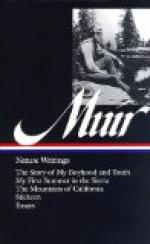[Illustration: Muir’s lake (fountain lake) and the garden meadow Sketched from the roof of the Bur-Oak Shanty]
This sudden plash into pure wildness—baptism in Nature’s warm heart—how utterly happy it made us! Nature streaming into us, wooingly teaching her wonderful glowing lessons, so unlike the dismal grammar ashes and cinders so long thrashed into us. Here without knowing it we still were at school; every wild lesson a love lesson, not whipped but charmed into us. Oh, that glorious Wisconsin wilderness! Everything new and pure in the very prime of the spring when Nature’s pulses were beating highest and mysteriously keeping time with our own! Young hearts, young leaves, flowers, animals, the winds and the streams and the sparkling lake, all wildly, gladly rejoicing together!
Next morning, when we climbed to the precious jay nest to take another admiring look at the eggs, we found it empty. Not a shell-fragment was left, and we wondered how in the world the birds were able to carry off their thin-shelled eggs either in their bills or in their feet without breaking them, and how they could be kept warm while a new nest was being built. Well, I am still asking these questions. When I was on the Harriman Expedition I asked Robert Ridgway, the eminent ornithologist, how these sudden flittings were accomplished, and he frankly confessed that he didn’t know, but guessed that jays and many other birds carried their eggs in their mouths; and when I objected that a jay’s mouth seemed too small to hold its eggs, he replied that birds’ mouths were larger than the narrowness of their bills indicated. Then I asked him what he thought they did with the eggs while a new nest was being prepared. He didn’t know; neither do I to this day. A specimen of the many puzzling problems presented to the naturalist.
We soon found many more nests belonging to birds that were not half so suspicious. The handsome and notorious blue jay plunders the nests of other birds and of course he could not trust us. Almost all the others—brown thrushes, bluebirds, song sparrows, kingbirds, hen-hawks, nighthawks, whip-poor-wills, woodpeckers, etc.—simply tried to avoid being seen, to draw or drive us away, or paid no attention to us.
We used to wonder how the woodpeckers could bore holes so perfectly round, true mathematical circles. We ourselves could not have done it even with gouges and chisels. We loved to watch them feeding their young, and wondered how they could glean food enough for so many clamorous, hungry, unsatisfiable babies, and how they managed to give each one its share; for after the young grew strong, one would get his head out of the door-hole and try to hold possession of it to meet the food-laden parents. How hard they worked to support their families, especially the red-headed and speckledy woodpeckers and flickers; digging, hammering on scaly bark and decaying trunks and branches from dawn to dark, coming and going at intervals of a few minutes all the livelong day!




